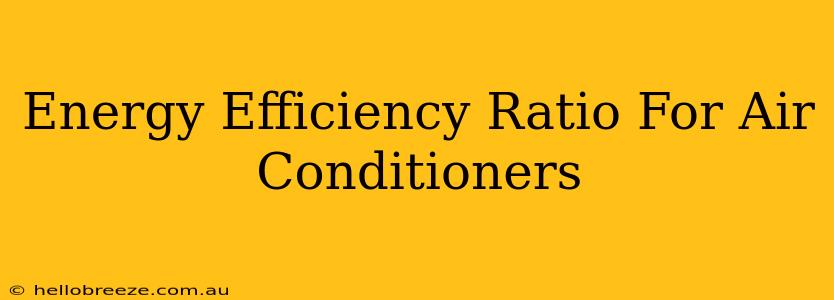Choosing the right air conditioner can significantly impact your energy bills and environmental footprint. One of the most crucial factors to consider is the Energy Efficiency Ratio (EER). Understanding EER is key to making an informed decision and saving money in the long run. This comprehensive guide will walk you through everything you need to know about EER for air conditioners.
What is the Energy Efficiency Ratio (EER)?
The Energy Efficiency Ratio (EER) is a measure of an air conditioner's energy efficiency. It represents the amount of cooling produced (in British Thermal Units or BTUs) for each watt of electricity consumed. A higher EER rating indicates a more efficient air conditioner, meaning it uses less energy to provide the same amount of cooling. In simpler terms, a higher EER means lower electricity bills.
How is EER Calculated?
EER is calculated by dividing the cooling capacity (BTUs per hour) by the power input (watts). The formula is:
EER = BTU/hour ÷ Watts
For example, an air conditioner with a cooling capacity of 12,000 BTUs per hour and a power input of 1,000 watts would have an EER of 12 (12,000 / 1,000 = 12).
Understanding EER Ratings and Their Significance
EER ratings vary depending on the air conditioner's model and technology. Generally, higher EER ratings are better. Here's a breakdown:
- EER below 8: Considered less efficient. These models are typically older and consume more energy.
- EER between 8 and 10: Moderate efficiency. These are a step up from lower EER models but may not offer the best savings.
- EER above 10: Highly efficient. These models are designed for energy savings and offer significant reductions in electricity consumption. Look for models with EER ratings of 12 or higher for optimal energy efficiency.
Factors Affecting Air Conditioner EER
Several factors influence the EER of an air conditioner:
- Technology: Inverter technology, for example, allows for more precise temperature control and reduces energy consumption compared to non-inverter models.
- Size: An appropriately sized air conditioner for your space is crucial. An undersized unit will work harder and consume more energy, leading to a lower EER in real-world conditions. Conversely, an oversized unit may cycle on and off frequently, also reducing its effective efficiency.
- Maintenance: Regular maintenance, including cleaning filters and coils, ensures optimal performance and helps maintain a high EER.
EER vs. SEER: What's the Difference?
While EER is a useful metric, the Seasonal Energy Efficiency Ratio (SEER) is often considered a more comprehensive measure of efficiency. SEER accounts for the varying temperatures throughout the cooling season, providing a more realistic representation of annual energy consumption. While EER focuses on a single point in time, SEER provides a more holistic view over an entire season. You'll often see SEER ratings advertised more prominently than EER ratings. A higher SEER rating is always preferable.
Choosing the Right Air Conditioner Based on EER
When selecting an air conditioner, consider these points:
- Your budget: Higher EER units typically have a higher upfront cost but offer significant long-term savings on energy bills.
- Your cooling needs: Choose a unit sized appropriately for your space to maximize efficiency. Consult a professional for help with sizing.
- Your climate: Consider the climate in your region when selecting an EER rating. In hotter climates, a higher EER might be even more beneficial.
Conclusion: Maximize Your Savings with High EER Air Conditioners
By understanding the Energy Efficiency Ratio (EER) and its impact on your energy consumption and cost, you can make a well-informed decision when purchasing an air conditioner. Investing in a high EER unit is an investment in energy savings, environmental responsibility, and long-term cost effectiveness. Remember to consider both EER and SEER ratings for a complete picture of your potential energy savings. Don't hesitate to consult with professionals for advice tailored to your specific needs and climate.

